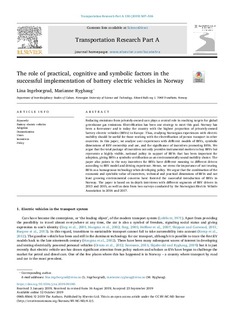| dc.contributor.author | Ingeborgrud, Lina | |
| dc.contributor.author | Ryghaug, Marianne | |
| dc.date.accessioned | 2020-03-03T08:05:39Z | |
| dc.date.available | 2020-03-03T08:05:39Z | |
| dc.date.created | 2019-10-14T11:10:34Z | |
| dc.date.issued | 2019 | |
| dc.identifier.citation | Transportation Research Part A: Policy and Practice. 2019, 130 507-516. | nb_NO |
| dc.identifier.issn | 0965-8564 | |
| dc.identifier.uri | http://hdl.handle.net/11250/2644798 | |
| dc.description.abstract | Reducing emissions from privately-owned cars plays a central role in reaching targets for global greenhouse gas emissions. Electrification has been one strategy to meet this goal. Norway has been a forerunner and is today the country with the highest proportion of privately-owned battery electric vehicles (BEVs) in Europe. Thus, studying Norwegian experiences with electric mobility should be useful for those working with the electrification of person transport in other countries. In this paper, we analyze user experiences with different models of BEVs, symbolic dimensions of BEV ownership and use, and the significance of incentives promoting BEVs. We argue that the total package of incentives not only provides instrumental motives to buy BEVs but represents a highly visible, national policy in support of BEVs that has been important for adoption, giving BEVs a symbolic certification as an environmentally sound mobility choice. The paper also points to the way incentives for BEVs have different meaning to different drivers according to BEV model and driving experience. Hence, we stress the importance of not treating BEVs as a homogenous technology when developing policy. We argue that the combination of the economic and symbolic value of incentives, technical and practical dimensions of BEVs and not least growing environmental concerns have fostered the successful introduction of BEVs in Norway. The paper is based on in-depth interviews with different segments of BEV drivers in 2013 and 2015, as well as data from two surveys conducted by the Norwegian Electric Vehicle Association in 2016 and 2017. | nb_NO |
| dc.language.iso | eng | nb_NO |
| dc.publisher | Elsevier | nb_NO |
| dc.rights | Attribution-NonCommercial-NoDerivatives 4.0 Internasjonal | * |
| dc.rights.uri | http://creativecommons.org/licenses/by-nc-nd/4.0/deed.no | * |
| dc.title | The role of practical, cognitive and symbolic factors in the successful implementation of battery electric vehicles in Norway | nb_NO |
| dc.type | Journal article | nb_NO |
| dc.type | Peer reviewed | nb_NO |
| dc.description.version | publishedVersion | nb_NO |
| dc.source.pagenumber | 507-516 | nb_NO |
| dc.source.volume | 130 | nb_NO |
| dc.source.journal | Transportation Research Part A: Policy and Practice | nb_NO |
| dc.identifier.doi | 10.1016/j.tra.2019.09.045 | |
| dc.identifier.cristin | 1736841 | |
| dc.relation.project | Norges forskningsråd: 209697 | nb_NO |
| dc.description.localcode | Open Access CC-BY-NC-ND | nb_NO |
| cristin.unitcode | 194,62,40,0 | |
| cristin.unitname | Institutt for tverrfaglige kulturstudier | |
| cristin.ispublished | true | |
| cristin.fulltext | postprint | |
| cristin.qualitycode | 2 | |

